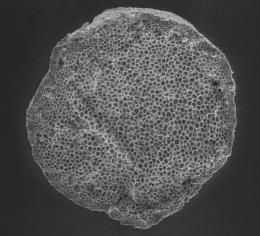(Press Release, Royal Holloway, University of London) — A team of scientists – led by Professor Andrew C Scott of the Department of Earth Sciences at Royal Holloway, University of London – have revealed that neither comet nor catastrophe were the cause for abrupt climate change some 12,900 years ago.
Theories of impacts and their influence on animal extinctions and climate change are receiving increasing attention both in the scientific and popular literature. Despite increasing evidence to dispute the theory, the idea that onset of the Younger Dryas (‘Big Freeze’) climate interval, mega-faunal extinctions, including mammoths, the demise of the North American Clovis culture, and a range of other effects, is due to a comet airburst and/or impact event has remained alive both through written and television media despite growing negative scientific evidence.
One key aspect of this claim centers on the origin of ‘carbonaceous spherules’ that purportedly formed during intense, impact-ignited wildfires. Theorists have used these ‘carbonaceous spherules’ as evidence for their comet impact-theories, but this new study concludes that those supposed clues are nothing more than fossilized balls of fungus, charcoal, and fecal pellets. These naturally-occurring organic materials also date from a period thousands of years both before and after the Younger Dryas period began, further suggesting that there was no sudden impact event.
The research team examined organic residues from some of the proposed sites to investigate the nature of these organic spheres and ‘carbon elongates’ that ranged in size from 1/2 to 2mm (1/10 inch).
Samples from Pleistocene-Holocene sedimentary sequences in the California Channel Islands and other sites show that carbon spherules and elongate forms are common in samples dating to before, during, and well after the 12,900-year time horizon, including from modern samples. Professor Scott says, “Importantly, we were able demonstrate that these organic spheres were found commonly in both modern and ancient sediments and were not just restricted to any particular layer”.
The researchers undertook a series of microscopic studies, including using the advanced Swiss Light Source to probe their internal structure using Synchrotron Radiation X-ray Tomographic Microscopy (SRXTM) to show that carbon spherules have morphologies and internal structures identical to fungal sclerotia (such as Sclerotium and Cenococcum). In investigating these objects, Professor Scott commented: “These spherules had been commonly seen by researchers but little attention was paid to them and so few images existed in the literature. Perhaps it is not surprising that they have been misidentified. Some of the elongate forms described in other pa pers by the impact supporters are arthropod fecal pellets, some almost certainly from termites”.
Professor Scott points out that “we should always have a skeptical attitude to new theories and to test them thoroughly and if the evidence goes against them they should be abandoned”. Professor Pinter, one the report’s authors, from Southern Illinois University, adds, “I think we have reached that stage with the Younger Dryas impact theory”.
The paper, entitled ‘Fungus, not comet or catastrophe, accounts for carbonaceous spherules in the Younger Dryas ‘impact layer’, is published in the journal ‘Geophysical Research Letters’.
Provided by Royal Holloway, University of London



I wonder if Pinter & Scott can come up with a convincing model to get those little particles of carbonized bug poop, and fungus, embedded into a Mammoth tusk.
Dennis, that was never claimed and never happened. CS is not embedded and cannot embed itself in mammoth tusk.
I know George.
Sorry, that was a weak attempt at a little sarcastic humor. I think Pinter,and Scott come off sounding a bit pompous. I figured I’d fire a shot.;)
It never ceases to amaze me how a whole hypothesis can be written off, as Dr. Scott appears to do re: The cosmic hypothesis of the Younger Dryas simply on one aspect of the wide ranging (not at all jusy confined to nanodiamonds and carbon spherules),admittedly the most controversial of the lines of evidence associated with the Younger Dryas. I do think that though the nanodiamond and carbon spherules proxy, though very important should not detract from the other pieces of evidence that strongly support the cosmic premise. Attention must be focused on these apsects as well!
It’s update time. From Evidence from central Mexico supporting the Younger Dryas extraterrestrial impact hypothesis
Potential Misidentification of Markers.
chicken little –
WTF are you talking about? Your comment has absolutely NOTHING to do with this topic. If you can’t comment ON topic, would you just go away? PLEASE.
Steve
CL, as usual, your comment is non sequitur, and ridiculous to the point of being absurd.
If you had even the remotest clue what kind of conditions it takes for nanodiamonds to form you wouldn’t ask such a stupid question.
But then again, most of us have given up on reading a comment from you that shows any evidence whatsoever of intelligent conscious thought. As Forest Gump may have said it: “Stupid is as stupid says”.
Here, this might help: http://dl.dropbox.com/u/2268163/NewMethod.pdf